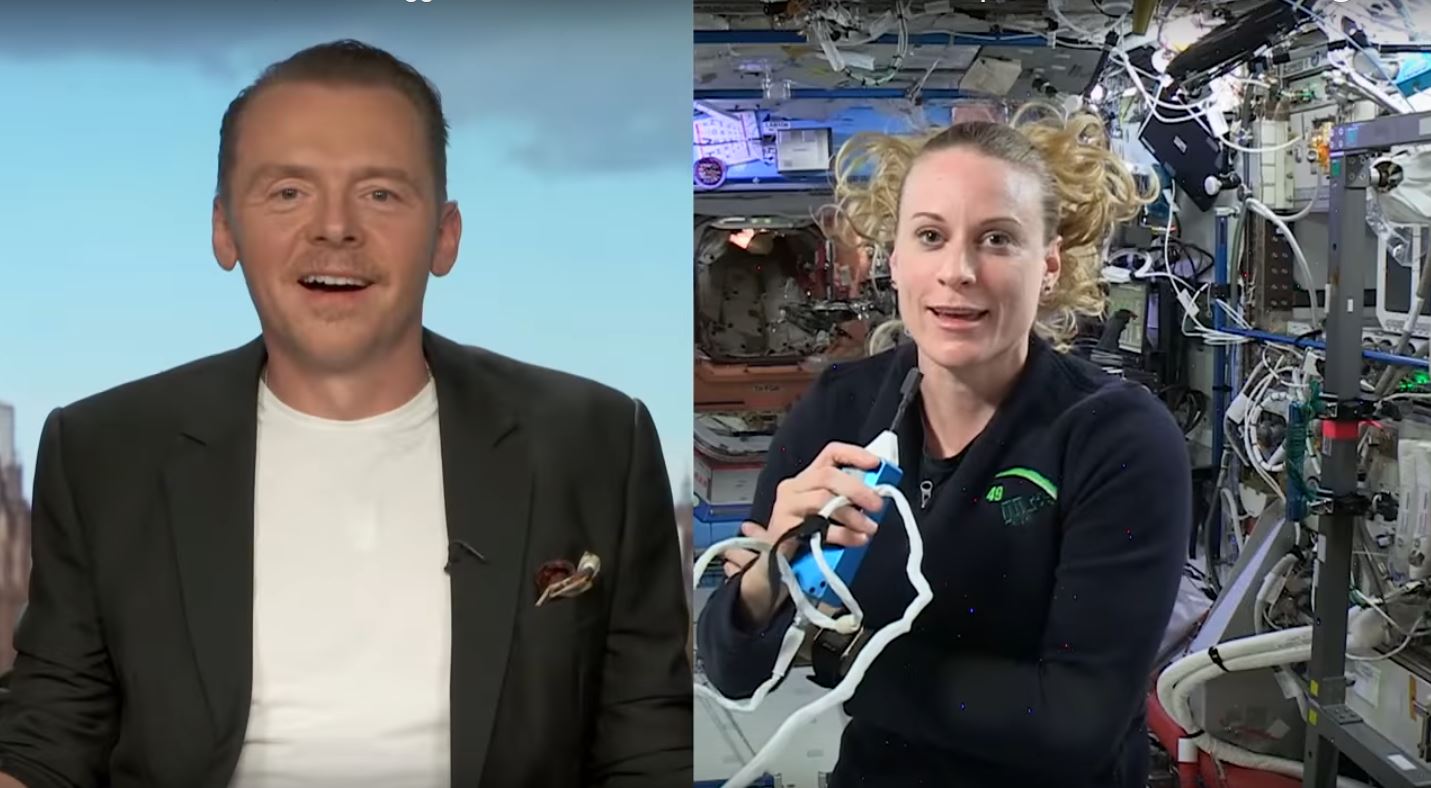'Star Trek' Actor Simon Pegg Talks Space Tech with Astronaut in Orbit

In a conversation with "Star Trek" actor and screenwriter Simon Pegg, space station astronaut Kate Rubins said she feels like she's living in the future — and that the iconic science fiction franchise is fairly accurate in representing life in orbit.
Paramount Movies uploaded the full, 25-minute video to YouTube this week as part of the company's promotion for the movie "Star Trek Beyond," which is available now on Digital HD and will be released on Ultra HD 4K and Blu-ray on Nov. 1.
"Your special effects guys get it right," Rubins said when recalling scenes of spacecraft orbiting planets in "Star Trek Beyond." She said she watched the movie this summer on an iPad in the International Space Station's cupola, whose seven windows offer a full view of Earth. [13 Things 'Star Trek' Gets Right (and Wrong) About Space Tech]
"That is incredible. I can't think of a more conducive environment to watch a science fiction movie than from space," said Pegg when he heard the story. Pegg plays chief engineer Montgomery Scott (aka Scotty) in the film, for which he also co-wrote the screenplay.
While Pegg said he is used to playing a fake astronaut (he has appeared in two other "Star Trek" movies), he expressed fascination with some of Rubins' daily activities on the space station. Rubins said she felt some disorientation during her first few weeks in space, trying to stay in an "up" position even though there is no up or down in a weightless environment.
Lately, however, she said she has the opposite problem. Ground control asked her to take pictures of exercise equipment with the top of the equipment in an "up" position. She admitted, "I couldn't get it right."
"It must be like sea legs times a thousand," quipped Pegg.
Get the Space.com Newsletter
Breaking space news, the latest updates on rocket launches, skywatching events and more!
"Star Trek" tech
This year is the 50th anniversary of the "Star Trek" franchise, and Pegg paid tribute to some of the ways the series has inspired real-life technology. He thought of the example of flip phones, he said, because they resemble the "tricorder" communicators used in "Star Trek: The Original Series." Rubins later added that she wished she had a tricorder on station to look at medical data (the fictional devices had many of the same functions as modern smartphones).
Another feature of the "Star Trek" universe is artificial gravity, which is a reality today — sort of. There are experiments on the station that can create artificial gravity using a centrifuge, which is a container that spins around very quickly, pushing its occupants against the outside edge. Some science fiction movies have portrayed centrifuge space stations.
Rubins said that just before speaking with Pegg, she was doing a microbiology centrifuge experiment with a drill that replicates artificial gravity on a small scale. She pointed out that to make it a reality for humans, the centrifuge would need to be much, much larger.
Pegg then asked Rubins if she does any special tricks in microgravity.
"Sometimes, I try to do them on camera for PAO [public affairs office] events," she said. A favorite activity of hers is pulling a bubble of water out of a drink bag and moving it along her hand, although she joked it looks like a horror movie once the bubble envelops her hand.
In the crew's spare time, Rubins has used microgravity for entertainment purposes. A recent weekend saw her and several other astronauts playing a new game on the walls and the ceilings of the ISS; she described it as a cross between football and Quidditch, the famous game from the "Harry Potter" fantasy franchise in which players fly around on broomsticks.
Global scale
Rubins also described her recent spacewalk outside the station, when she and her colleagues worked to prepare the orbiting complex for the arrival of new commercial crew vehicles in the coming years. She said her biggest problem was not fear — that's trained out of astronauts, she said — but containing her impatience to get outside immediately.
"I had to almost hold on inside because I was so excited to get out that hatch," she said. "It was just an incredible experience."
Rubins said she particularly enjoyed the view of Earth in the spacesuit; she also spends a lot of time looking at the Earth through the station windows. Station crew members take a lot of photos of the Earth, she said, adding that she experienced some disorientation while taking pictures because "your normal scale doesn't catch up" when looking at the planet. Michigan and the city of Vancouver are visible in one view, or all of Europe. "It takes a while to get used to that."
Rubins and two of her Expedition 49 crewmates (Russian astronaut Anatoly Ivanishin and Japanese astronaut Takuya Onishi) are expected to land in Kazakhstan at 11:59 p.m. EST (3:59 a.m. UTC) on Saturday (Oct. 30). You can follow coverage of the landing at Space.com.
Follow Elizabeth Howell @howellspace, or Space.com @Spacedotcom. We're also on Facebook and Google+. Original article on Space.com.
Join our Space Forums to keep talking space on the latest missions, night sky and more! And if you have a news tip, correction or comment, let us know at: community@space.com.

Elizabeth Howell (she/her), Ph.D., was a staff writer in the spaceflight channel between 2022 and 2024 specializing in Canadian space news. She was contributing writer for Space.com for 10 years from 2012 to 2024. Elizabeth's reporting includes multiple exclusives with the White House, leading world coverage about a lost-and-found space tomato on the International Space Station, witnessing five human spaceflight launches on two continents, flying parabolic, working inside a spacesuit, and participating in a simulated Mars mission. Her latest book, "Why Am I Taller?" (ECW Press, 2022) is co-written with astronaut Dave Williams.











